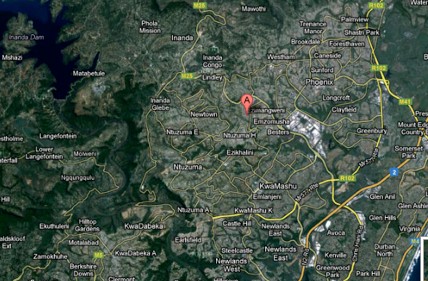
By Susan Yoon
The townships of Inanda, Ntuzuma, and KwaMashu (INK) were built as satellite settlements of the City of Durban during apartheid, pre-1986. The region is part of the eTehkwini Metropolitan Area (formerly Durban), within the KwaZulu-Natal province. The region is set in hilly terrain, 20 kilometers inland from the Durban Commercial Business District, (See Figure 1). The Inanda, Ntuzuma, and KwasMashu (INK) area was designated in 2001 as one of eight nodes in the Urban Renewal Programme, designed to integrate services and develop infrastructure in informal settlements, (Everatt & Smith, 2008).
The Department Provincial and Local Government, (DPLG, 2006), estimates the population of the INK area to be 487,406; the land area to be 70.13 square kilometers; and the population density to be 6,950 square kilometers. The urban population of this area is 99.4 percent; the unemployment rate is 55.0 percent; and 50.5 percent of the population lives in informal dwellings. There is a mix of informal and formal economic activity. Among the major employment sectors are social services, manufacturing, and retail trade, (DPLG, 2006). There is a low in-migration rate (8.0 percent migration within the past 5 years) compared to other Urban Renewal Nodes in South Africa, (Everatt & Smith, 2008). (The population figures appear to be from 2001 Census data and may be undercounted. Statistics South Africa (SSA, 2011), issued a report stating that undercounting in the KwaZulu-Natal region was as high as 25 percent.)
Properly treated water supply needs to be provided from the nearby Inanda Dam (see Figure 2) through updated treatment facilities and extension of the piped network. Currently, more than two-thirds (68 percent) of households in the INK nodal area are without piped water, compared to 37.7 percent in South Africa as a whole, (Everatt & Smith, 2008). Since the 1980’s, with the building of the dam, clean water supply has been a contentious issue within the settlements. The construction of Inanda Dam, was seen as a necessary provision for supplying water to the eThekwini Metropolitan Area. However, it also led to the displacement of thousands of people, (Scott, 1988), and there has been continued concern over pollution and mercury contamination in the rivers that feed into the Inanda Dam, (Papu-Zamxaka et al., 2010).
First, access to adequately treated piped water is imperative. Second, climatic change should be taken into consideration in developing future water usage plans. Since 1994, the Environmental Management Department of eThekwini and the Municipal Climate Protection Program, led by Debra Roberts, have worked to develop adaptation plans that will combat future ecological disasters, including flooding and contamination, and the subsequent spread of disease and crop shortages. Proactive strategies such as sustainable water harvesting need to be initiated. Analysis of flood control must be conducted, and disaster management strategies must be integrated into the municipality’s Integrated Development Plan, (Roberts, 2010).
This article is a product of Professor Shagun Mehrotra’s Global Urban Environmental Policy class. Views expressed are entirely those of the individual author.
References
Everatt, D., & Smith M. (2008). Building Sustainable Livelihoods in, Inanda. Department of Social Development, Republic of South Africa, 2008. Retrieved from http://www.population.gov.za/pop_dev/index2.php?option=com_docman&task=doc_view&gid=235&Itemid=162
Google. (2012). Google Earth (Version 6.0.3.2197) [Software]. Available from http://www.earth.google.com
Marx, C., & Charlton, S. (2003).The case of Durban, South Africa. UN Habitat, Understanding Slums: Case Studies for the Global Report 2003. Retrieved from http://www.ucl.ac.uk/dpu-projects/Global_Report/pdfs/Durban.pdf.
Papu-Zamxaka, V., Mathee, A., Harpham, T., Barnes, B., R??llin, H., Lyons, M., & Cloete, W. (2010). Elevated Mercury Exposure in Communities Living Alongside the Inanda Dam, South Africa. Journal of Environmental Monitoring, 2010, 12, 472-477. DOI: 10.1039/b917452d.
Roberts, D. (2010). Prioritizing Climate Change Adaptation and Local Level Resilience in Durban, South Africa. Environment and Urbanziation, 22, 397-413. DOI: 10.1177-0956247810379948
Scott, D., & Diab, R. D. (1989). Indanda Dam: A Case Study of the Social Impacts of the Infrastructural Development in the South African Context. International Journal of Environmental Studies, 1989, 34, 43-55.
Statistics South Africa. (2011). Census Undercount and Strategies, Version 6. Statistics South Africa, 2011. Retrieved from http://www.statssa.gov.za/census2011/documents/Census_2011_Undercount%20Strategies-version_6a.pdf